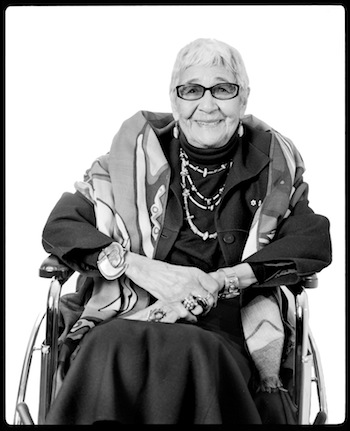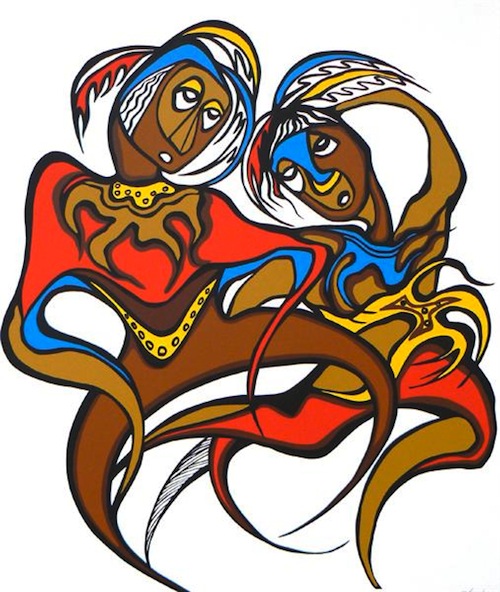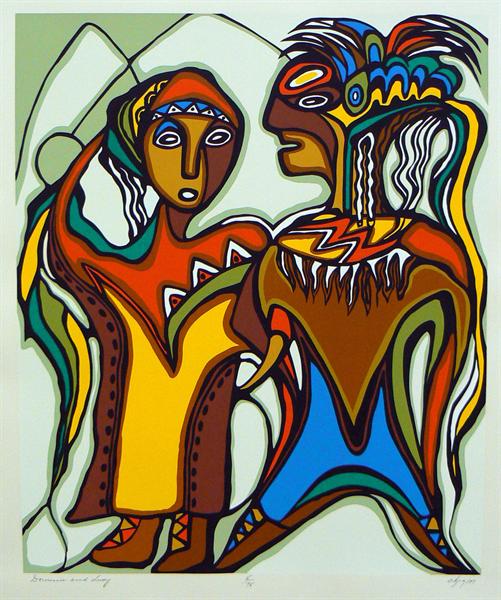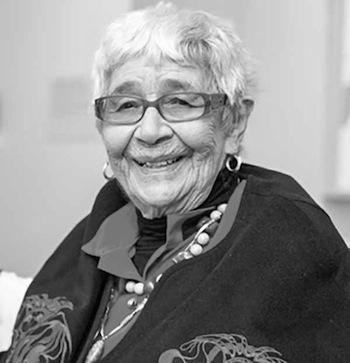Image Caption
By Dianne Meili
Windspeaker.com ARCHIVES
Even as a young girl, Daphne Odjig was resourceful and creative, turning the family farm pig house into a play school to teach local children math and reading.
When they tired of her instruction, she converted the school to a play church, sitting in priest-like serenity to hear her students’ confessions.
Growing up, Odjig designed needlework patterns for Jesuit Mission church linens, but it would take a meeting with Elders at a powwow on Manitoulin Island to turn her sights from Christian themes and realism to sought-after images of Manitoulin mysticism.
“Some Wikwemikong women told her ‘you have a chance now, you have a voice and you need to start painting our myths and legends to tell people who the Ojibway people are’,” said Jackie Bugera, owner of Edmonton’s Bearclaw Gallery where Odjig’s final 2011 retail gallery exhibit was held.
“She always called herself an ‘Indian’ but she admitted she didn’t know what an Indian was back in the 60’s. She and her sisters were walking around the powwow in buckskin dresses and headbands, but they really didn’t know if that was their Ojibway culture,” Bugera added.
Odjig painted the legends the community women shared with her and soon after mounted her first exhibition. Prime Minister Lester B. Pearson saw it and purchased the entire collection.
Born in 1919 on Manitoulin Island in Ontario, Odjig sketched for fun with her grandfather, Jonas Odjig, who carved monuments and tombstones, and her father Dominic, who painted war scenes and portraits of soldiers from the Great War.
Her family was among the Potawatomi who migrated north and settled in Wikwemikong after the War of 1812.
Rheumatic fever forced her out of school and into bed for three years; she hated to quit school but never regretted being able to spend time with her mother and grandfather at home. Both passed away within weeks of each other in 1938.
By 1942 she left home and found factory work in Toronto, changing her name to “Fisher”, an old English interpretation of Odjig, in response to racism. On her days off, she frequented the gallery at the Eaton’s College Street store, inspired to teach herself to paint by trial and error.
In 1945 she married Paul Somerville, a Mohawk Métis war veteran, moving with him across the country to British Columbia.
While raising her two boys, she experimented with oils on homemade stretchers and recycled tent canvas. She became dissatisfied with realism, choosing to experiment with Cubism and Abstract Expressionism she saw in books and magazines.
“If you look through old catalogues of Daphne’s work, you can see how she began altering space and dimension by analyzing and copying artists like Picasso and Van Gogh,” said Bugera. “At the same time, she’s using dark lines and connecting images which shows the Ojibway woodland influence.”
Initially jolted by her husband’s death in a car accident, Odjig soldiered on and planted the family farm’s strawberry fields in the summer of 1962, finding time to paint during the winter, still interpreting the works of European impressionists.
Her second husband, Chester Beavon, moved the family to northern Manitoba in his work as a development officer. Odjig’s drawings of the hardship faced by the Chemahawin Cree displaced by the Grand Rapids dam, along with paintings of Ojibway legends, figured largely in her first public solo exhibition at the Lakehead Art Centre in Thunder Bay.
Next, she was commissioned by Dr. Herbert Schwarz to paint erotic illustrations for his book Tales from the Smokehouse – artwork that comprised an exhibition in Brandon, Manitoba.
“I laughed when Daphne told me what Dr. Schwarz said when he saw her first efforts at erotica: he told her to make the genitalia larger, much larger,” recalls Bugera.
Odjig’s Earth Mother exhibit at Japan’s Expo 70, viewed by Picasso himself, reflected a looser and more expressionistic style. She learned to scale-up her drawings to paint murals, completing The Great Flood at Peguis High School in Hodgson, Manitoba.
In 1972, Odjig’s art took her to Winnipeg for a pivotal exhibition, Treaty Numbers 23, 287 and 1171, with Jackson Beardy and Alex Janvier. In the two men, she found support and strength as the only female Aboriginal artist struggling for recognition in mainstream galleries, a situation made all the more trying because she was a self-taught artist without an art degree.
She was the sole woman, again, in the Professional Native Artists Association (known as the “Indian Group of Seven”) she co-founded along with Carl Ray, Joseph Sanchez, Eddy Cobiness, Norval Morrisseau, Beardy and Janvier.
Emboldened, she opened the New Warehouse Gallery in Winnipeg, a venture featuring emerging Aboriginal artists. With increased demand for their art, she and her husband expanded the business in 1974.
Commissions, invitations for artistic residencies, honorary university degrees, and awards flowed in throughout the next decades.
Odjig and her husband moved back to British Columbia in the late 1990’s. Officially retiring in 1999, she continued to draw and paint even though she had arthritis in her right hand.
The 2011 show Bugera mounted at the Bearclaw Gallery consisted of works from Odjig’s private collection, works she had saved for herself during her lengthy career.
“Even though she wasn’t well enough to attend, I had line-ups of people waiting to get in. I finally shouted ‘if you want a painting, pull the tag off the wall and hang onto it’ because everyone was grabbing whatever they could,” Bugera said.
Odjig was a nurturing and caring person who was a joy to work with, according to Bugera. “She was tall and elegant, always well put-together. She loved her turquoise jewellery and when she’d bring art in, she’d trade for pieces she just had to have.”
The artist hoped young people would follow in her footsteps and create expressions of their heritage more openly and joyfully than even she had.
Odjig passed away on Oct. 1 in Kelowna, with her family at her bedside. She was 97.




